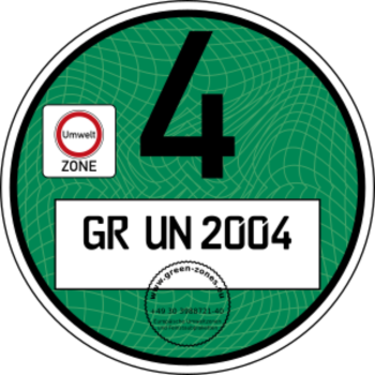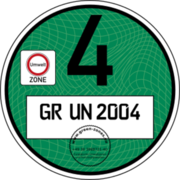Further Information
Introduction (goal, intention, purpose)
The aim of the German environmental zones and environmental stickers is to combat and reduce carcinogenic air pollutants for all people in Germany. Diesel soot particles and fine dust in particular were a major problem and in some cases still are today. In conurbations, the levels in some places were 8 to 10 times higher than in rural areas. Zones and stickers were therefore introduced as a solution to reduce urban traffic.
The cities of Berlin, Cologne and Hanover were the first to introduce the German environmental stickers on 01.01.2008. One year later, the number of environmental zones already grew to 15. In the course of the last year, more and more cities were added, so that there are now almost 60 zones and over 80 cities.
Legal basis
The introduction of the environmental badge bases on the ordinance on the identification of less pollutant vehicles from the 10.10.2006, published on the Official Journal of the Federal Republic of Germany on the 16.10.2006 and entered into force on the 01.03.2007, also known under the code 35. BImSchV.
According to this text, cities, municipalities and communities are allowed since the 01.03.2007 to set up on their territory so called environmental zones, in which traffic will be restricted. Vehicles not bearing a valid environmental badge are not allowed to drive in these zones.
In the 1st ordinance on the modification of the ordinance on the identification of the less emitting vehicles, the German Bundesrat decided on the 14.11.2007, in accordance with the prescriptions of the federal government, to add a regulation about the G-Kat catalysators et about systems for the reduction of fine particles emissions.
The introduction of environmental zones in Germany bases on two directives from the European Union:
The directive 1996/62/EG from the Council about the observation and the control of air quality dated 27.09.1996, in which the EU permits the European cities to introduce environmental zones under the article 8 paragraph 3, and the directive 1999/30/EG from the Council dated 22.04.1999, about the legal emissions rates for nitrogen dioxide, nitrogen monoxides, sulphur dioxide, fine particles and plumb in the air, as indicated under article 5, paragraph 5.
In the law 39. BImSchVabout air quality et the legal maximum emissions rates, thedirective 2008/50/EG from the European parliament and the Council dated 21 of Mai 2008 about air quality and pure air in Europe has been transposed in the German national law on the 02.08.2010.
Features (appearance, description)
There are three environmental stickers with three different colours: red, yellow and green. The environmental stickers have a diameter of 80 millimetres with a black border 1.5 millimetres thick. The numbers on the stickers (2, 3, and 4) are 35 millimetres high and are in black RAL 9005. The lettering field for the label is 60 x 20 millimetres and is in pure white RAL 9010.
The official colour of the red sticker is traffic red RAL 3020.
Traffic yellow RAL 1023 is the official colour of the yellow sticker.
The green sticker has the official colour traffic green RAL 6024.
Cities
The following cities have one or more environmental zones and the green environmental sticker is mandatory:
Aachen, Augsburg, Balingen, Berlin, Bochum, Bonn, Bottrop, Bremen, Castrop-Rauxel, Darmstadt, Dinslaken, Dortmund, Duisburg, Düsseldorf, Erfurt, Eschenweiler, Essen, Frankfurt a. M, Freiburg im Breisgau, Gelsenkirchen, Gladbeck, Hagen, Halle Saale, Hanover, Heidelberg, Heidenheim, Heilbronn, Herne, Herrenberg, Herten, Ilsfeld, Karlsruhe, Cologne, Krefeld, Langenfeld, Leipzig, Leonberg / Hemmingen and surrounding area, Limburg, Ludwigsburg and surrounding area, Magdeburg, Mainz, Mannheim, Marburg, Mönchengladbach, Mühlacker, Mühlheim, Munich, Münster, Neuss, Neu-Ulm, Oberhausen, Offenbach, Osnabrück, Overath, Pfinztal, Pforzheim, Recklinghausen, Regensburg, Remscheid, Reutlingen, Ruhr area, Schramberg, Schwäbisch Gmünd, Siegen, Stuttgart, Tübingen, Ulm, Urbach, Wendlingen, Wiesbaden, Wuppertal
Affected vehicles
The following vehicles are affected by the German environmental zones and require a green environmental sticker on entry:
Car, motorhome (M1), minibus (M2), coach (M3), van (N1), truck (N2), heavy truck (N3)
Not affected are motorcycles such as motorcycles or agricultural and forestry machinery.
Which stickers do I get? (classification)
Penalties (fines)
With the amendment of the German catalogue of fines as of 09.11.2021 it was determined that driving in an environmental zone without a valid environmental sticker or stopping or parking in an environmental zone without a valid environmental sticker is subject to a fine of 100 euros.
Under the offence number 141621 it is regulated there that despite a traffic ban to reduce harmful air pollution, a motor vehicle was involved in the traffic. In addition to the fine of 100 euros, there is a final processing fee of approximately 25 euros.
Important to know for foreigners:
From a fine of 70 euros or more, according to EU Directive 2011/82 of 25.10.2011 "to facilitate the cross-border exchange of information on traffic offences which jeopardise road safety", if the fine is not paid, enforcement proceedings will take place in the home country and will continue until the prison sentence is passed.
Exemptions
General exception rules about the obligation of bearing an environmental badge in the German environmental zones are defined in the article 35 of the German federal law for air protection.
According to this text, the following vehicles are exempted from the obligation of bearing a badge:
1) Machines and mobile equipment,
2) Work machines,
3) Agricultural and forestry tractors,
4) Two-wheelers and three-wheelers*,
5) Ambulances, medical vehicles referring to the mention “medical emergency intervention”,
6) Vehicles driven by or transporting particularly disabled, helpless or blind persons. These vehicles are distinguished by a special parking referring to the prescriptions of the §1, n°1-3 of the German federal directive about the signalization of vehicles for persons with disabilities, containing the mentions “Ag”, “H”, or “BI”,
7) Vehicles concerned by the prescriptions written in the paragraph § 35 of the German traffic regulations code,
8) Vehicles of non-German military forces or of military forces from non-signatory States of the North Atlantic Treaty, stationing in Germany as part of a cooperation mission, if they are used for moves concerning urgent military matters,
9) Civil vehicles driven by the German Bundeswehr for moves urgent and indispensable moves regarding the accomplishment of territorial missions of the Bundeswehr,
10) Antique cars distinguished with the mention “H” on the registration plate, in accordance with the prescriptions of the paragraph §9-1 and §17 of the German directive on the vehicles registration or Vehicles from en other EU member state or from an member state of the European Economic Area or from Turkey responding to the above-mentioned requirements.
*Quad bikes are vehicles from the category L and are thus exempted from the obligation of bearing an environmental badge.
FAQ
How long is my sticker valid?
Unless the engine or exhaust emission standard of the vehicle or the registration number changes, the sticker is valid for the entire lifetime of the vehicle. This means you do not have to buy a new one every year.
Where must my sticker be affixed?
The environmental sticker must be stuck to the left or right inside of the windscreen. It does not matter whether it is on the top or the bottom. The main thing is: clearly visible!
Does my sticker have to be affixed?
Yes, the sticker is only valid if it is stuck to the windscreen. § 3 of the 35th BImSchV is very clear.
"To identify a motor vehicle, the sticker must be attached to the inside of the windscreen in a clearly visible position. The sticker must be designed and affixed in such a way that it self-destructs when detached from the windscreen".
May several green environmental stickers be attached to the windscreen?
No! Only the environmental sticker with the currently valid license plate may be attached. It must be clearly and immediately recognizable from the outside. If several stickers with different license plates are stuck to the windscreen, an inspection can result in a fine of 80 euros.
What is the best way to remove the old stickers?
The old stickers can be removed best with a sticker scraper (similar to a glass scraper) or you can carefully heat the sticker with a heat gun so that the glue comes off. Caution! The difference in temperature, especially on cold days, could damage the windscreen.
What happens if the license plate fades?
Our stickers have a 2-year UV protection guarantee - and that without any ifs and buts! Just send us a picture of the faded sticker and we will send you a new one immediately and free of charge.
My windshield is broken and needs to be replaced. What happens to the sticker?
The environmental sticker is such that it will be destroyed when you remove it, so you will have to buy a new one. In many cases, insurance companies will cover not only the cost of the new windscreen but also the cost of the new sticker. A new sticker must therefore be purchased.
Can I still get the yellow or red sticker?
Unfortunately no. In all environmental zones in Germany, only the green environmental sticker is still valid. The only zone in which the yellow sticker is still valid is Neu-Ulm.
What happens if my license plate changes?
As soon as the license plate changes, e.g. if you move house, a new sticker must be ordered.





